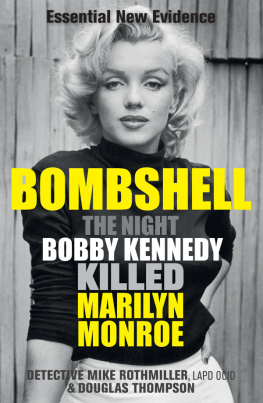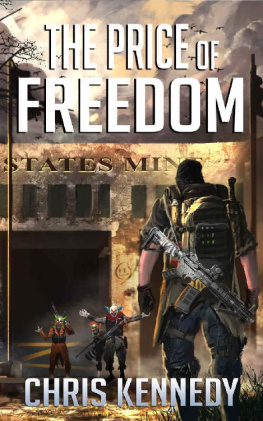Chappaquiddick
Tragedy
Kennedys
Second Passenger
Revealed
Donald Frederick Nelson
PELICAN PUBLISHING COMPANY
G retna 2016
Copyright 2016
By Donald Frederick Nelson
All rights reserved
The word Pelican and the depiction of a pelican are
trademarks of Pelican Publishing Company, Inc., and are
registered in the U.S. Patent and Trademark Office.
Library of Congress Cataloging-in-Publication Data
Nelson, D. F. (Donald Frederick), 1930- author.
Chappaquiddick tragedy : Kennedys second passenger revealed / Donald Frederick Nelson.
pages cm
Includes bibliographical references and index.
ISBN 978-1-4556-2114-9 (hardcover : alk. paper) ISBN 978-1-4556-2115-6 (e-book) 1. Kennedy, Edward M. (Edward Moore), 1932-2009. 2. Kopechne, Mary Jo, 1941-1969. 3. Keough, Rosemary 4. Traffic accidentsMassachusettsChappaquiddick Island. 5. Chappaquiddick Island (Mass.)History. I. Title.
E840.8.K35N45 2015
973.92092dc23
[B]
2015026651
Printed in the United States of America
Published by Pelican Publishing Company, Inc.
1000 Burmaster Street, Gretna, Louisiana 70053
Several decades have passed since Edward M. Kennedys Oldsmobile Delmont 88 careened off Dike Bridge on Chappaquiddick Island in 1969, killing Mary Jo Kopechne. Can anything new be said about the mysteries left behind by the cover-up surrounding that wreck? After you read this account, I think you will answer, Yes! And what you will read is based solidly on recorded facts of the time that are all cited in the notes at the end of this book. This is not a work of imagination or conspiracy theories.
When all legal action against Kennedy ended and the inquest testimony was released, the New York Times editorialized, The case is closed, says the Dukes County District Attorney. So it is in a legal sense; but it is not resolved. And that unresolved case involved a prominent U.S. senator and had national political repercussions. It was, in fact, the most famous automobile accident of the twentieth century! Clarity, understanding, and resolution are needed. Historical truth demands them.
How has Chappaquiddick defied resolution? Several factors have served to entangle peoples thinking about the cover-up. First is confusion about what was being covered up. After all, Kennedy admitted to being the driver who left the scene of a fatal accident, so what was left for him to cover-up? Had he done something worse? Imagination and conspiracy theories quickly took charge of some peoples thinking. Then, political leanings entered to produce sympathy or antipathy, prejudicing the viewpoint and detracting from objective evaluation of known evidence. Misplaced trust in some participants accounts also led to acceptance when skepticism was needed. Finally, the abysmally inadequate police investigation and prosecutorial questioning at the inquest produced no resolution to the Chappaquiddick case.
How have I avoided these pitfalls? It all started with a rumor I heard long ago about a third person in Kennedys car. It was interesting because it accounted for some of the peculiarities of the case, but it was just a rumor. Later I chanced upon a Bill Kurtis presentation of Investigative Reports: Chappaquiddick on A&E and was fascinated to see how the forensic evidence he presented was consistent with that scenario. After Kennedy died, when I felt I would not be accused of political motives one way or the other, I decided to explore the Chappaquiddick documents, press coverage, and earlier analyses from the viewpoint of that story. It directed me to pose different questions, be skeptical of previous interpretations, and reject the conspiracies and pure imaginings of some previous writers. As supporting information accumulated, I realized in steps that I wasnt exploring a rumor or scenario or story but was discovering the true account of the Chappaquiddick accident and how the participants handled it.
This account can, must, and does stand on its reason, facts, and citations. In spite of the many previous examinations of this accident, I have found an unanalyzed piece of evidence, an ignored interview, a never-understood inquest testimony, and an uninterpreted participant statement, each unappreciated or unexplored before now, that serve as keys to unlock the mysteries of the cover-up. When you finish this book, I think you will say, That makes sense! That pulls the cover off the cover-up. That solves the Chappaquiddick case.
The many reinvestigations of the Chappaquiddick accident, such as those by the Boston Globe in 1974 and the New York Times in 1980, have added to the original records. So have the authors of previous books, particularly Leo Damore, with his investigative reporting and interviews with participants in Senatorial Privilege: The Chappaquiddick Cover-up, a book still worth reading. Bill Kurtiss Investigative Reports: Chappaquiddick broadcast on A&E and available on DVD presented useful forensic evidence and interviews. These contributions have become a part of the historical records that I have built upon, and I wish to acknowledge their importance to this work.
I also want to thank Leslie H. Leland, foreman of the grand jury; John N. Farrar, the Edgartown Fire Department water-rescue expert; and Howie Hall, a crewman on Kennedys boat, Victura , in the regatta, for their interviews with me. Their clarifications are described in the text and cited in the notes. In addition, I wish to thank Nicholas Lamar Soutter for his support of this writing project.
Lastly I want to thank my wife, Mickie, for her patience throughout my researching and writing of this book.
Map of Chappaquiddick Island (Mapping Solutions)
It was to be a fun weekend with competitive sailing, partying with a group of close friends, and relaxing away from the pressure cooker of Washington politics. It was the weekend of the annual Edgartown Yacht Club Regatta on Marthas Vineyard Island and, with the Senate going into a three-day recess, a perfect July weekend for Edward Ted Kennedy to throw a party. He would be sailing in the regatta with his close cousin Joseph A. Gargan, as he had for many years. The party was to be a reprise of a much-appreciated party held a year earlier for the six young, single women whose intense involvement in Robert F. Kennedys presidential campaign had left them grief-stricken following his assassination on June 5, 1968.
The six had worked in Bobby Kennedys tense and confidential campaign boiler room, where convention delegate support was counted and monitored. It was the nerve center of the campaign, and its committed staff shared an esprit de corps. After the assassination, the six had remained bonded, perhaps even more strongly so, and Ted felt he should lend continuing support to his brothers devoted staff through a friendly, relaxed getaway. Ted needed it too, for he had been the most keenly affected of all, having then lost two brothers to assassination. The 1968 party was a small but important event during the ten weeks that Ted spent out of the national spotlight recovering from shock, overcoming sadness, and evaluating his new identity as the Kennedy standard bearer. That sailing weekend with old friends had been helpful, return-to-normal therapy for all of them.










